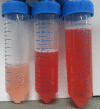Alveolar Hemorrhage Caused by the Combination of Immune Checkpoint Inhibitors (ICIs) and Angiogenesis Inhibitors: The Underlying Long-Term Vascular Endothelial Growth Factor (VEGF) Inhibition
- PMID: 35449623
- PMCID: PMC9012575
- DOI: 10.7759/cureus.23272
Alveolar Hemorrhage Caused by the Combination of Immune Checkpoint Inhibitors (ICIs) and Angiogenesis Inhibitors: The Underlying Long-Term Vascular Endothelial Growth Factor (VEGF) Inhibition
Abstract
The combination of immune checkpoint inhibitors (ICIs) and other anticancer agents is the standard of care for various cancers. Bevacizumab, an anti-angiogenesis inhibitor, causes serious adverse events such as pulmonary hemorrhage (PH). Here, we present a case of drug-induced diffuse alveolar hemorrhage (DAH), an adverse event, in a patient with hepatocellular carcinoma who was treated with a combination of ICIs and anti-angiogenesis inhibitors after long-term use of lenvatinib, which inhibits vascular endothelial growth factor (VEGF). An 85-year-old man with hepatocellular carcinoma initially received lenvatinib, a multi-kinase inhibitor, but the drug was later switched to bevacizumab-atezolizumab combination therapy owing to disease progression. After five cycles, he developed dyspnea and diffuse ground-glass opacities, which improved with discontinuation of the combination therapy and initiation of steroid pulse therapy. Our case findings indicate that both ICIs and anti-angiogenesis inhibitors cause drug-induced DAH, and their combination may increase the severity of DAH. Moreover, long-term VEGF inhibition may induce the development of DAH. Clinicians need to be aware that long-term VEGF inhibition may be associated with DAH and should consider the risk management of such adverse events while using this combination therapy.
Keywords: adverse events; anti-angiogenesis inhibitor; combination therapy; diffuse alveolar hemorrhage; immune checkpoint inhibitor; long-term vegf inhibition.
Copyright © 2022, Shijubou et al.
Conflict of interest statement
The authors have declared that no competing interests exist.
Figures




Similar articles
-
Durvalumab-Induced Diffuse Alveolar Hemorrhage: An Autopsy Case Report.Case Rep Oncol. 2020 Jun 22;13(2):696-701. doi: 10.1159/000507848. eCollection 2020 May-Aug. Case Rep Oncol. 2020. PMID: 32774259 Free PMC article.
-
Advances in Immune Checkpoint Inhibitors for Advanced Hepatocellular Carcinoma.Front Immunol. 2022 Jun 10;13:896752. doi: 10.3389/fimmu.2022.896752. eCollection 2022. Front Immunol. 2022. PMID: 35757756 Free PMC article. Review.
-
Diffuse alveolar hemorrhage with pseudoprogression during nivolumab therapy in a patient with malignant melanoma.Thorac Cancer. 2018 Nov;9(11):1522-1524. doi: 10.1111/1759-7714.12872. Epub 2018 Sep 25. Thorac Cancer. 2018. PMID: 30253076 Free PMC article.
-
Atezolizumab with or without bevacizumab in unresectable hepatocellular carcinoma (GO30140): an open-label, multicentre, phase 1b study.Lancet Oncol. 2020 Jun;21(6):808-820. doi: 10.1016/S1470-2045(20)30156-X. Lancet Oncol. 2020. PMID: 32502443 Clinical Trial.
-
Therapeutic implication of vascular endothelial growth factor receptor-1 (VEGFR-1) targeting in cancer cells and tumor microenvironment by competitive and non-competitive inhibitors.Pharmacol Res. 2018 Oct;136:97-107. doi: 10.1016/j.phrs.2018.08.023. Epub 2018 Aug 28. Pharmacol Res. 2018. PMID: 30170190 Review.
Cited by
-
Immune checkpoint inhibitor-induced myocarditis and myositis in liver cancer patients: A case report and literature review.Front Oncol. 2023 Jan 11;12:1088659. doi: 10.3389/fonc.2022.1088659. eCollection 2022. Front Oncol. 2023. PMID: 36713559 Free PMC article.
-
Hemoptysis in Cancer Patients.Cancers (Basel). 2023 Sep 28;15(19):4765. doi: 10.3390/cancers15194765. Cancers (Basel). 2023. PMID: 37835458 Free PMC article. Review.
References
-
- Updated analysis of KEYNOTE- 024: pembrolizumab versus platinum-based chemotherapy for advanced non-small-cell lung cancer with PD-L1 tumor proportion score of 50% or greater. Reck M, Rodríguez-Abreu D, Robinson AG, et al. J Clin Oncol. 2019;37:537–546. - PubMed
-
- Nivolumab plus ipilimumab or nivolumab alone versus ipilimumab alone in advanced melanoma (CheckMate 067): 4-year outcomes of a multicentre, randomised, phase 3 trial. Hodi FS, Chiarion-Sileni V, Gonzalez R, et al. Lancet Oncol. 2018;19:1480–1492. - PubMed
-
- Immunostimulation with chemotherapy in the era of immune checkpoint inhibitors. Galluzzi L, Humeau J, Buqué A, Zitvogel L, Kroemer G. Nat Rev Clin Oncol. 2020;17:725–741. - PubMed
Publication types
LinkOut - more resources
Full Text Sources
